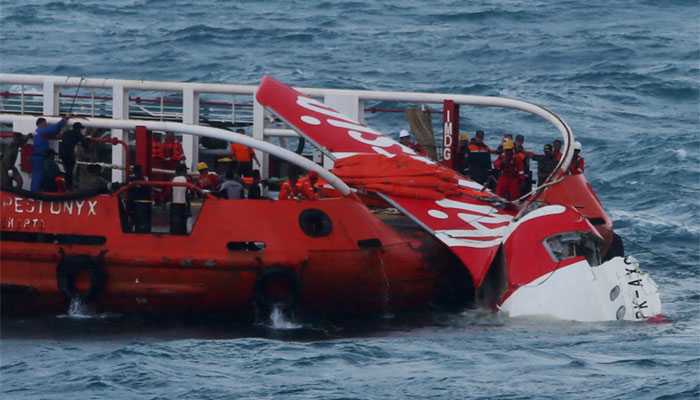In this file photograph taken on January 10, 2015, Indonesian search and rescue personnel pull wreckage of AirAsia flight QZ8501 onto the Crest Onyx ship at sea. AFP
AFP/Jakarta
Faulty equipment and the crew's "inability to control the aircraft" led an AirAsia A320 to crash into the Java Sea last year, killing all 162 people onboard, a report said on Tuesday.
Flight QZ8501 went down in stormy weather on December 28, during what was supposed to be a short flight from the Indonesian city of Surabaya to Singapore.
The crash of the Airbus A320-200 triggered a huge international search, with ships and aircraft from several nations involved in a lengthy hunt that was hampered by strong currents and bad weather. The bodies of 56 victims were never recovered.
In their final report into the accident released Tuesday, Indonesia's official National Transportation Safety Committee said a major factor was a fault with a system that helps control the rudder's movement.
Cracked soldering in the component caused it to malfunction and send repeated warning messages to the pilots.
When they received the fourth warning, the pilots pulled circuit-breakers on one of the aircraft's computers, removing power from the faulty system in a bid to reset it. But in doing so, they also turned off the plane's autopilot.
"Subsequent flight crew action resulted in inability to control the aircraft," said the report. The plane went into a "prolonged stall condition that was beyond the capability of the crew to recover", it said.
It added the flight data recorders did not indicate the weather had affected the aircraft.
The report said the faulty component, the Rudder Travel Limiter, had suffered 23 problems in the past 12 months, citing maintenance records.
String of aviation disasters
A minister previously described how the plane climbed fast and then went into aerodynamic stall, losing lift, before it went down, while an investigator said the warning alarms were "screaming" as the pilots desperately tried to stabilise the aircraft.
Investigators had also revealed that the French co-pilot, Remi Plesel, was at the controls of the AirAsia plane in the moments before it crashed, rather than the more experienced pilot, Captain Iriyanto, who had around 20,000 hours of flying time.
Rescuers faced difficulties in the choppy waters of the Java Sea, but the main body of the plane was eventually located on the seabed by a Singapore navy ship and both black box data recorders were recovered.
Search efforts were finally called off in March after almost three months of hunting.
It was one of several aviation disasters in the sprawling archipelago in the past year, and the first major setback for Malaysia-based AirAsia group and its flamboyant boss Tony Fernandes after a spectacular run of success.
In August, a turbo-prop plane operated by Indonesian domestic carrier Trigana crashed in the remote, eastern region of Papua during a short flight in bad weather, killing all 54 people on board.
And in June an Indonesian military plane went down into a residential neighbourhood in the city of Medan, exploding in a fireball and killing 142 people.
Indonesian airlines are expanding rapidly after years of strong economic growth led to the emergence of a new middle class, who have the money to fly around the archipelago of more than 17,000 islands rather than travel by road or sea.
But existing infrastructure is inadequate and carriers are struggling to find enough well-trained personnel to keep up with the boom, experts say.



